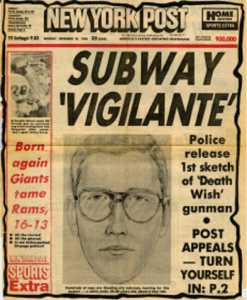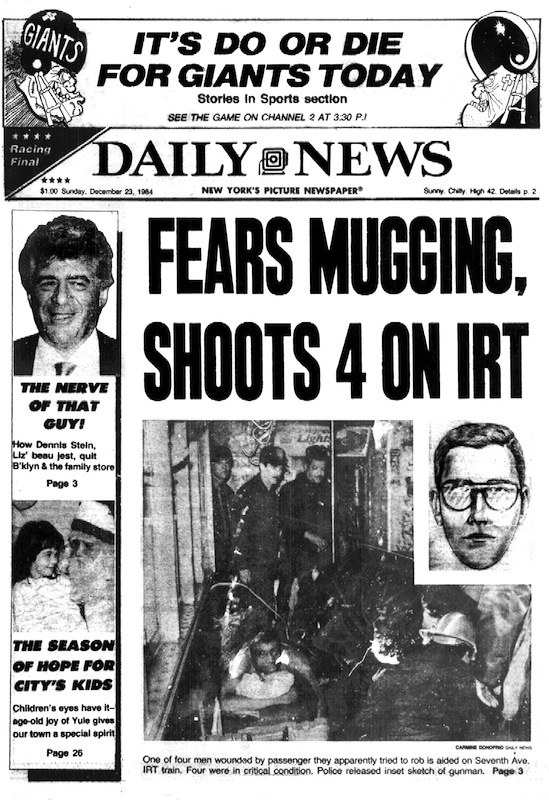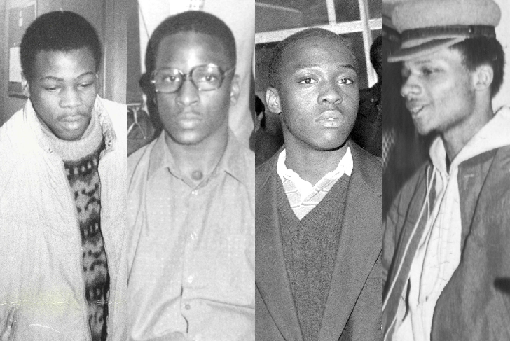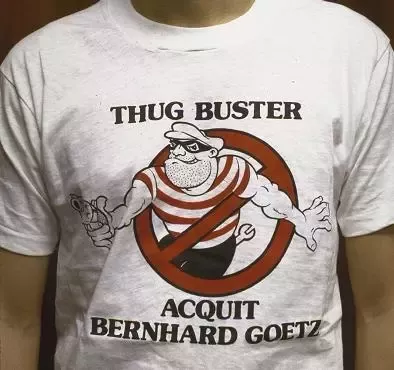“Subway Vigilante” Bernhard Goetz: A Look Back at the Kyle Rittenhouse of the 80s
Posted By Travis LeBlanc On In North American New Right | Comments DisabledOn December 22, 1984, 37-year-old electrical engineer Bernhard Goetz stepped onto the downtown #2 subway train to Lower Manhattan where he intended to meet with some friends for drinks before the Christmas holidays. Goetz is a half-Jew on his mother’s side, but little did he know that by the end of this fateful train ride, he would be a full-fledged honorary Aryan.
Goetz boarded the train at the 14th Street stop, whereupon he was greeted by fellow passengers Barry Allen, Troy Canty, Darrell Cabey (all 19 years of age), and James Ramseur (18). Despite what their normal-sounding names would suggest, all four were black, and (surprise, surprise) all four had criminal records [3] for petty crime.
Goetz took a seat on the train directly across from Troy Canty. For 10 seconds, Troy Canty sized up the thin and bespectacled Goetz. “How you doing?” Canty asked. “I’m fine.” Goetz replied.
Having made the woeful miscalculation that this new passenger was easy meat, the black teenagers stood up from their seats and surrounded Goetz. Canty then said “Give me five dollars.”
Goetz looked at the gentlemen, stood up, and asked Canty to repeat what he said. Canty did. Goetz then said, “Yes. I’ve got five dollars for each of you.” Goetz reached into his jacket, but instead of his wallet, he took out a .38 caliber Smith and Wesson revolver. He then proceeded to put a bullet into each one of them in quick succession, shooting two in the chest and two in the back.
What happened next would be the most controversial aspect of the story, and it is disputed whether or not it even happened. But according to Goetz’s own statements during his initial police interview, he then walked over to Darrel Cabey, who was slumped over in a short corner seat. Goetz looked over Cabey, and said either “You don’t look so bad. Here’s another” or “You look all right. Here’s another” before shooting Cabey once more at point-blank range.
At this point, someone had pulled the train’s emergency brake. With the shooting stopped, Goetz approached the terrified bystanders in the car and asked if they were okay. The train conductor entered the car and Goetz told him “They tried to rob me and I shot them.” The conductor asked Goetz to hand over his gun and Goetz refused.
Goetz then walked between two subway cars and jumped onto the tracks before running south down the tunnel and escaping at the Chambers Street stop. If he had then kept his mouth shut and just gone about the rest of his life, he might never have been found. He would remain a fugitive for 9 days before turning himself in to New Hampshire police.
The infamous 1984 New York subway shooting [5] was one of the most explosive race controversies of its era. The matter was endlessly debated by Goetz’s legions of supporters and detractors. To some, he was a hero, an everyman fighting back against the criminal menace that the establishment was either unable or unwilling to do anything about. To others, he was a trigger-happy madman, or worse, a racist.
But as the decades have gone by, the subway shooting has become overshadowed by another hot-button race controversy from the same decade and the same city: the 1989 case of the Central Park Five [6]. Compared to the Central Park Five incident, the Bernhard Goetz case has been relatively memory-holed, though not entirely. Parallels to the Goetz case were invoked after the Trayvon Martin and Ahmad Arbury shootings.
But you would think that a white guy shooting four black guys and getting found not guilty for it by a mostly-white jury would be something that liberals would never let you forget about. But if you look at subsequent events and how things played out, you can start to understand why it isn’t.
First, there are the black shooting victims. By the time Bernhard Goetz was finally acquitted for attempted murder in 1987, two of them were in jail and one of them was in rehab [8]. Only Darrell Cabey had managed to keep himself out of trouble, but that was because the shooting had left him paralyzed from the waist down. Shortly after the shooting incident, Troy Canty became addicted to crack cocaine, was arrested for shoplifting in 1990, and his current whereabouts are unknown. Barry Allen would be arrested for robbery in 1991 and did some time in prison before being released in 1995. Like Canty, he has also fallen off the face of the earth.
But James Ramseur wins the prize. In March 1985, Ramseur made a false police report [9] where he claimed that two men hired by Goetz attempted to kidnap him, but he was able to escape from the car. Canty claimed that he was “testing the police.” Despite the hoax being quickly exposed, Ramseur was not charged with making a false police report. Undeterred, Ramseur would be arrested in 1986 for raping, sodomizing, and robbing a pregnant woman on a Bronx rooftop. He was already in jail by the time Goetz’s trial began. On the witness stand, Ramseur lost his temper during cross-examination, which resulted in him being held in contempt of court. He was at last released from prison in 2002, but was back inside by 2005 for parole violation. He got out again in 2010 only to die a year later from an overdose of prescription pills on December 22, 2011, the 27th anniversary of the shooting.
Liberals understandably have chosen not to die on this hill. The Central Park Five is easy to hammer into narrative compliance: five black teenagers stitched up for murder as a villainous Donald Trump cheered, only for the real murderer to clear their names decades later. The fact that there are still mountains of evidence suggesting they were present for the rape and murder is a detail that can be easily downplayed. The guy who did it said they weren’t there!
By contrast, there is no chance of meme-ing any of the four people shot by Goetz into gentle giants planning on attending community college in the fall. No hope of getting anyone to cry salty tears over a rapist getting shot. So the whole thing has been comparatively forgotten.
However, the incident has inspired quite a bit of pop culture, including multiple episodes of Law & Order and the Michael Douglas film Falling Down, about a white male everyman who goes off the rails after getting tired of society’s crap. Saturday Night Live made a sketch about Goetz [10]. Goetz is named in the Billy Joel song “We Didn’t Start the Fire” (“Foreign debts, homeless vets, AIDS, crack, Bernie Goetz”). Todd Phillips, who wrote and directed 2019’s Joker, modeled Joachim Phoenix’s character in part on Bernhard Goetz and the turning point of the film is when Phoenix murders some bullies on the subway Goetz-style.
 [11]
[11]Goetz inspired a subplot in the 1985 Spectacular Spider-Man 4-issue storyline “The Death of Jean DeWolff.”
Bernhard Goetz was born on November 7, 1947. His father was a German immigrant and his mother was a Jewish convert to Lutheranism. Goetz was born in Queens, but raised upstate where his father ran a dairy farm and a bookbinding business. When Goetz was 12, his father was convicted of molesting two 15-year-old boys. Shortly afterward, Goetz and his sister were sent off to boarding school in Switzerland.
Goetz would return to America in 1965. He enrolled in New York University where he received degrees in electrical engineering and nuclear engineering. He reportedly was able to avoid the Vietnam War by pretending to be mentally ill. After college, he spent some time in Orlando where his family had relocated and was briefly married. After his marriage fizzled out in 1975, Goetz moved back to New York City, where he set up an electronics shop that he ran out of his Manhattan apartment.
In 1981, Goetz was transporting electronic equipment across town when he was mugged by 3 black youth in a Canal Street subway station. According to Goetz, the black youth pushed him to the ground, injuring his knee, and even attempted to throw Goetz through a glass door.
The experience left Goetz traumatized. Seeing as he spent a lot of time lugging expensive electronic equipment around from place to place, he decided it might be a good idea to carry a gun. New York City has some of the strictest gun control laws in the country, and while Goetz went through the legal process to acquire a permit to carry, he was turned down. Nevertheless, he subsequently purchased a gun on his next trip to Florida and made a habit of carrying it with him at all times.
New York City had struggled with an escalating crime problem all throughout the 1970s, but by the mid-80s, a new drug hit the streets that made the problem worse by an order of magnitude.
The origins of crack are disputed, but it is generally believed that the practice of boiling cocaine and baking soda together began in the Caribbean. At first, users would purchase their cocaine, go home, and turn it into crack. Then one day, an enterprising Los Angeles drug dealer named Freeway Ricky Ross [13], noticing that many of his customers were doing this, got an idea. He would turn the cocaine into crack himself and sell it. It was just a smart bit of customer service. Ross called it “ready rock,” rock cocaine that was ready to be smoked right away. No assembly required. The gimmick worked, and eventually, Ross became the biggest drug dealer in Los Angeles. Other drug dealers across the country began imitating Ross’ innovation and this was the beginning of the crack epidemic.
By 1984, crack had hit the streets of New York in a major way. The drug was more addictive than anything seen before, and its effect on users more frightening. Crack addicts became soulless zombies devoid of all humanity or morality, black holes whose entire existence revolved around acquiring more and more crack. Crack addicts were so notoriously unpredictable, erratic, and aggressive that even the police were frightened to deal with them.
It was within this context that the 1984 subway shooting occurred.

Looking back on the shooting from a 2021 perspective, one of the most shocking things about it is that it was not initially interpreted as a racial event. That would come later. In fact, a New York Times poll [14] released January 14, 1985, a mere three weeks after the event, found that 52% of respondents believed that the shooting was justified while only 28% said it was unjustified. 13% were undecided and the remaining 7% had not heard enough about the incident to have an opinion.
But the real curveball comes when you break those numbers down by race:
- Whites: 56% supported Goetz, 26% opposed
- Blacks: 45% supported Goetz, 33% opposed
- Hispanics: 48% supported Goetz, 26% opposed
- Men: 56% supported Goetz, 27% opposed
- Women: 48% supported Goetz, 28% opposed
Consider that kind of cross-racial support for a white-on-black shooting today. It’s unimaginable.
Some more interesting facts from the poll: 60% cited crime as New York’s biggest problem, four times higher than the second most common answer, housing, which was cited by 15% of respondents. 28% of respondents said that they or a family member had been a victim of crime in the last year. When asked “Do you think there are so many muggings and holdups in New York City that people have a right to take matters into their own hands, or not?”, 43% of respondents said yes while 47% said no.
On top of this, the black teenagers were known to be carrying sharpened screwdrivers. The teens themselves said that they used the screwdrivers to break open arcade games to steal the quarters. Indeed, two weeks before the shooting, Darrell Cabey had been arrested for doing just that. They were also on their way to rob an arcade at the time of the shooting. Whatever their intended purpose, the screwdrivers could easily have been used as weapons, and thus the teens were not “unarmed.”
The teens themselves claimed that they were not attempting to rob Goetz and were merely panhandling. This doesn’t seem plausible. If they wanted to panhandle, it would make sense for them to split up so that they could cover more area. Darrell Cabey would later admit in an interview that the four were indeed intending to rob Goetz. Cabey’s lawyer would claim that he was delirious when he said this.
Even before he turned himself in and his identity was known, Goetz had become an instant folk hero and was compared to Charles Bronson’s vigilante character in Death Wish. Indeed, the movie Death Wish contains a scene [17] where Bronson wastes a couple would-be muggers on a subway.
Upon his return to New York City, Goetz was given a hero’s welcome by the people and followed by the media everywhere he went. Hundreds offered to help pay for his legal defense. He was initially arraigned on charges of attempted murder and illegal gun possession and sent to Rikers Island. Bail was set at $50,000, but then lowered to $5,000. Goetz raised the bail himself and was out after 5 days.
The honeymoon was short-lived, however. The tide of public opinion began to turn when the district attorney released portions of his police interview where he. . . .
How do I put this?
Well, he kind of started fedposting.
My reading of Bernhard Goetz is that he is an autiste. His posture and manner of speaking suggest it, but more importantly, Goetz displayed a certain kind of social tone-deafness that is so prevalent among autistes. He tells you what he honestly thinks and feels with a seemingly suicidal disregard for consequences.

Put yourself in Goetz’s shoes. You’ve just shot 4 black kids who were trying to mug you on the subway. Now you are sitting in the police station being interviewed by the cops. What do you do? Of course, you should exercise your right to remain silent and refuse to answer any questions without an attorney. Well, Goetz waived those rights.
Okay, on to Plan B. Plan B is that you keep it simple. “Look, these kids were surrounding me. They were about to rough me up. I felt threatened. I had been mugged before and I was scared. So I shot them in self-defense.” That’s it. That’s all you need to say.
But Goetz? What does he say? Oh, just stuff like:
Two were on my right and two were on my left. I knew at that point I would have to pull the gun. When I saw the smile on his face and the shine in his eyes, that he was enjoying this, it was at that point that I knew I was gonna kill them all, murder them all, do anything.
At another point, he says:
If I had more bullets, I would have shot ‘em all again and again. I was gonna gouge one of the guy’s eyes out with my keys afterwards. . . .
I wanted to kill those guys. I wanted to maim those guys. I wanted to make them suffer in every way I could. And you can’t understand this because it’s a realm of reality that you’re not familiar with.
Well, you can’t accuse him of being an optics cuck. Rather than a reluctant vigilante, he now looked like a guy who might have some issues. Whether or not his actions were justified, he sounded like he enjoyed shooting those kids a little too much. I can sympathize with wanting to wipe the smirk off the face of a sociopath, but optics, Bernie! Optics!
In this way, Bernie Goetz was not unlike Richard Jewell in that he naively spoke openly and sincerely with the media and law enforcement, seemingly oblivious to the fact that these institutions were not his friends.
But the real bombshell came when Goetz told the story of walking up to Cabey, saying “You look alright. Here’s another one” before shooting him again at point-blank range. That part was not public knowledge until then.
It’s one thing to shoot someone in self-defense, but you are only allowed to defend yourself enough to eliminate the threat. If the “Here’s another one” story was true, he was attempting to kill someone who was no longer a threat.
This is what I mean when I say “socially tone-deaf”. I don’t think he was aware of just how damaging that was to say, and at this point, he had over a week to get his story together.
Lucky for Goetz, prosecutors would have a hard time proving that last bit happened. For one, Cabey was only shot one time, not twice, which would mean either one of the shots missed or the “here’s another one” part didn’t happen. Secondly, only one witness recalled seeing Goetz approach Cabey to shoot him a second time. Eight other witnesses said they heard all the shots fired in quick succession, hearing no pause before a final shot.
 [20]
[20]Goetz receiving the Courageous Citizen Award from the Federation of New York Rifle and Pistol Clubs.
The release of the interview footage gave ammunition to Goetz’s detractors. To them, Goetz was a ticking time bomb with a few screws loose who prowled the subways looking for any excuse to use his shiny new toy. He was, as the blacks would say, “wishin’ a nigga would.”
This also gave more plausibility to the claims of Al Sharpton, who was on the scene trying to make it a black-white issue. According to the Al Sharptons of the world, Goetz shot the kids because they were black. Had the kids been white, Goetz would not have started shooting until they had started physically mugging him. He would have given white kids the benefit of the doubt — maybe they were just panhandling. But because they were black, he assumed their bad intentions and started blasting them before they started getting violent or even threatened violence.
Who knows? Maybe that’s true. But that’s like talking about what someone would do if a white person put Gorilla Glue in their hair. Well, white people don’t do stuff like that, so it’s a completely pointless hypothetical.
Whatever someone’s political beliefs were, Goetz became a poster child for them. For the gun rights activists, he was an example of someone who was able to use a gun to protect himself. To gun control activists, he was an example of how reckless an untrained guy with a gun could be. To liberals, he was a racist. To conservatives, he represented justice, a private citizen who did do what those big-government liberals couldn’t.
Goetz was ultimately able to beat the attempted murder and assault charges, but was convicted for illegal gun possession, serving 8 months in prison. Legal fees cost Goetz over a quarter of a million dollars.
However, liberals managed to score a symbolic consolation prize in the 90s when Gabey filed a civil suit against Goetz. This time, the jury was mostly black, and the plaintiff’s attorney specifically selected jurors who had previously been the victims of discrimination. On top of this, they were able to dig up a racist statement by Goetz from 1980. It came to light that at a local neighborhood watch meeting, Goetz said that the only way to clean up the neighborhood was to “get rid of all the niggers and spics.”
Based mischling! But extremely bad optics. Yes, it was 1980, and while frank talk about race was a lot more common then, that kind of language was generally reserved for casual conversation among friends. It was still a faux pas in a formal setting. I see this as more evidence of Goetz being socially tone-deaf.
The jury in the civil trial awarded Cabey $43 million. Goetz filed for bankruptcy the next week, has paid nothing, and says he has no intention of ever doing so.
Bernhard Goetz is still alive. He still lives in the same one-room apartment in Union Square that he did in 1984. He still travels around town by subway, but no longer carries a gun. He still does the occasional interview, and he still doesn’t give a damn about optics.
In 2013, he was contacted by the Daily Beast [21] for his opinion on the Zimmerman verdict. “I don’t know if Zimmerman was a good guy or a bad guy,” Goetz said. “I’m convinced Trayvon was a bad guy.”
“The country really has better things to be concerned about than this phony story. There are certainly more important things going on than somebody killing a thug, whether it’s a good guy or a bad guy killing a thug.” Goetz adds “America is focusing on the wrong issue in this particular story. What they should be focusing on is prosecutorial misconduct.”
This last part sums up the Zimmerman and Goetz cases well:
People automatically take the position, well, if you’re the victim and you get the shit beaten out of you, well, then you’re a good guy. But if you’re in the unusual case where the victim turns on the aggressor and fucks up the aggressor, then there’s the question, is the original victim a good guy or a bad guy?
In the case of Bernhard Goetz, we know the answer to that.
* * *
Don’t forget to sign up [22] for the weekly email Counter-Currents Newsletter for exclusive content, offers, and news.








